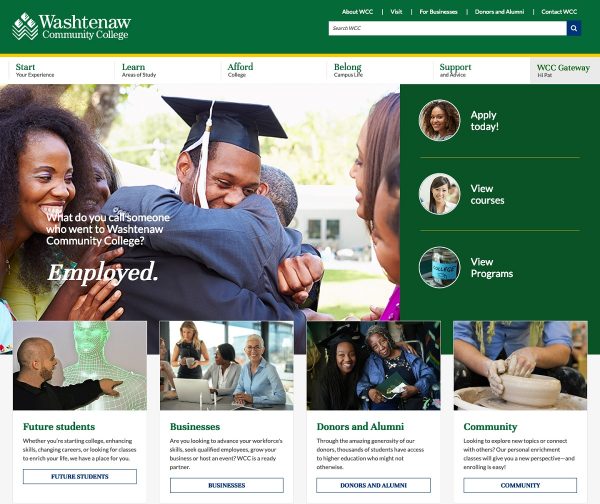
A screenshot of the new WCC website. Nicholas Ketchum | Washtenaw Voice
By Nicholas Ketchum
Deputy Editor
The Voice confirmed the launch of a new, public-facing college website has been postponed—but not indefinitely.
Last March, the Voice reported the college’s plan to “soft launch” a new website later that month. A soft launch is an event when a product or service initially opens—but with limits—as in this case, where the new website was assigned its own URL.
The soft launch itself occurred as scheduled on March 25 at new.wccnet.edu, but the new website was only sporadically available by the end of summer.
No public updates on the new website have been announced since March.
The project, according to previous Voice reports, has been ongoing since at least July 2017, costing an estimated $350,000. It includes a revamped look-and-feel with improved responsiveness for mobile devices and a simplified navigation structure, among other changes.
The current website is at least 10 years old, which is considered old age for a website.
What happened?

Brendan Prebo, associate vice president of marketing and communications is familiar with the new website. Courtesy of Brendan Prebo
Brendan Prebo, associate vice president of marketing and communications at WCC, is familiar with the project.
He said the website’s functionality should be improved before a full rollout—particularly increasing download speeds and responsiveness of the website’s various pages and applications.
Responsive websites refer to the ability of a website’s layout to automatically adapt to a variety of devices and screens, such as desktop computers, laptops, tablets and smartphones.
“We looked at the functionality of the website…. some of the functionality we thought could be improved,” he said. “We wanted to take another look and make sure when we launch, the user experience is best in class because so much of the business with students is done through the website.”
Prebo said user-facing features such as look-and-feel, user interface, navigation and overall functionality will remain unchanged.
“The way it looks and the way it’s laid out, I think we’re very happy with; and the content we’re very happy with,” he said.
Prebo attributed unforeseen issues to poor communication between vendors, as well as difficulties testing a complex website before all components are complete and working in unison.
What’s the plan from here?
Prebo said no significant changes to vendors or architecture were necessary, aside from an additional module from OU Campus, which will cost $15,000.
OU Campus is a commercial web content management system for higher education and similar institutions.
He said purchasing the module is more cost effective than developing it in-house.
“It’s really a way to look at the resources in a different way and be more efficient in how we apply those resources,” he said.
Prebo said one lesson his team is taking away is to plan smaller, faster iterations as they build the website; smaller chunks of functionality would be easier to implement and test.
“Say, if we have 10 things we know we’re going to do with the next phase of the website, not try to do all 10 and launching at once,” he said. “But rather take them in chunks that make sense and launch them as they’re developed and ready. We’re looking at reducing the scope of each phase so that we can get through it faster and improve the user experience quicker.”
At this point, Prebo isn’t discussing launch timelines, instead saying he’s looking forward to putting the website in front of students this semester and getting their input.
He said the college will hold focus groups to gather more feedback.
Prebo said when the website is ready for a full launch, his office will be in communication with the campus community with more details.
Correction: A print version of this story incorrectly mentioned a launch window for public rollout. Instead, this window will be used to gather student feedback before a full launch.

